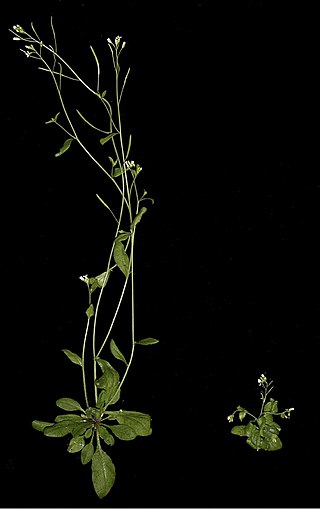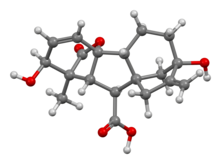
Germination is the process by which an organism grows from a seed or spore. The term is applied to the sprouting of a seedling from a seed of an angiosperm or gymnosperm, the growth of a sporeling from a spore, such as the spores of fungi, ferns, bacteria, and the growth of the pollen tube from the pollen grain of a seed plant.

Dormancy is a period in an organism's life cycle when growth, development, and physical activity are temporarily stopped. This minimizes metabolic activity and therefore helps an organism to conserve energy. Dormancy tends to be closely associated with environmental conditions. Organisms can synchronize entry to a dormant phase with their environment through predictive or consequential means. Predictive dormancy occurs when an organism enters a dormant phase before the onset of adverse conditions. For example, photoperiod and decreasing temperature are used by many plants to predict the onset of winter. Consequential dormancy occurs when organisms enter a dormant phase after adverse conditions have arisen. This is commonly found in areas with an unpredictable climate. While very sudden changes in conditions may lead to a high mortality rate among animals relying on consequential dormancy, its use can be advantageous, as organisms remain active longer and are therefore able to make greater use of available resources.

Plant hormones are signal molecules, produced within plants, that occur in extremely low concentrations. Plant hormones control all aspects of plant growth and development, including embryogenesis, the regulation of organ size, pathogen defense, stress tolerance and reproductive development. Unlike in animals each plant cell is capable of producing hormones. Went and Thimann coined the term "phytohormone" and used it in the title of their 1937 book.

In botany and horticulture, parthenocarpy is the natural or artificially induced production of fruit without fertilisation of ovules, which makes the fruit seedless. The phenomenon has been observed since ancient times but was first scientifically described by German botanist Fritz Noll in 1902.
Gibberellins (GAs) are plant hormones that regulate various developmental processes, including stem elongation, germination, dormancy, flowering, flower development, and leaf and fruit senescence. GAs are one of the longest-known classes of plant hormone. It is thought that the selective breeding of crop strains that were deficient in GA synthesis was one of the key drivers of the "green revolution" in the 1960s, a revolution that is credited to have saved over a billion lives worldwide.

Abscisic acid is a plant hormone. ABA functions in many plant developmental processes, including seed and bud dormancy, the control of organ size and stomatal closure. It is especially important for plants in the response to environmental stresses, including drought, soil salinity, cold tolerance, freezing tolerance, heat stress and heavy metal ion tolerance.

The sultana is a "white", oval seedless grape variety also called the sultanina, Thompson Seedless, Lady de Coverly (England), and oval-fruited Kishmish. It is also known as İzmir üzümü in Turkey since this variety has been extensively grown in the region around İzmir. It is assumed to originate from Asia Minor, which later became part of the Ottoman Empire.

Gibberella is a genus of fungi in the family Nectriaceae.

Plant senescence is the process of aging in plants. Plants have both stress-induced and age-related developmental aging. Chlorophyll degradation during leaf senescence reveals the carotenoids, such as anthocyanin and xanthophylls, which are the cause of autumn leaf color in deciduous trees. Leaf senescence has the important function of recycling nutrients, mostly nitrogen, to growing and storage organs of the plant. Unlike animals, plants continually form new organs and older organs undergo a highly regulated senescence program to maximize nutrient export.

Stenospermocarpy is the biological mechanism that produces parthenocarpy (seedlessness) in some fruits, notably many table grapes.
Aleurone is a protein found in protein granules of maturing seeds and tubers. The term also describes one of the two major cell types of the endosperm, the aleurone layer. The aleurone layer is the outermost layer of the endosperm, followed by the inner starchy endosperm. This layer of cells is sometimes referred to as the peripheral endosperm. It lies between the pericarp and the hyaline layer of the endosperm. Unlike the cells of the starchy endosperm, aleurone cells remain alive at maturity. The ploidy of the aleurone is (3n) [as a result of double fertilization].
Seed dormancy is an evolutionary adaptation that prevents seeds from germinating during unsuitable ecological conditions that would typically lead to a low probability of seedling survival. Dormant seeds do not germinate in a specified period of time under a combination of environmental factors that are normally conducive to the germination of non-dormant seeds.
A seedless fruit is a fruit developed to possess no mature seeds. Since eating seedless fruits is generally easier and more convenient, they are considered commercially valuable.

Bakanae or bakanae disease, from the Japanese for "foolish seedling", is a disease that infects rice plants. It is caused by the fungus Gibberella fujikuroi, the metabolism of which produces a surplus of gibberellic acid. In the plant, this acts as a growth hormone, causing hypertrophy. The affected plants, which are visibly etiolated, chlorotic, and which are at best infertile with empty panicles, producing no edible grains; at worst, they are incapable of supporting their own weight, topple over, and die.

Gibberella fujikuroi is a fungal plant pathogen. It causes bakanae disease in rice seedlings.
GAI or Gibberellic-Acid Insensitive is a gene in Arabidopsis thaliana which is involved in regulation of plant growth. GAI represses the pathway of gibberellin-sensitive plant growth. It does this by way of its conserved DELLA motif.

Karrikins are a group of plant growth regulators found in the smoke of burning plant material. Karrikins help stimulate seed germination and plant development because they mimic a signaling hormone known as strigolactone. Strigolactones are hormones that help increase growth of symbiotic arbuscular mycorrhizal fungi in the soil, which enhances plant growth and leads to an increase in plant branching.

The Pixie Grape is a new type of Vitis vinifera cultivar. The Pixie is a natural dwarf grapevine that is derived from the periclinal L1/L2 chimera Pinot Meunier. These dwarf grapevines tend to have short internodes and prefer to grow flowers instead of tendrils. They grow from 1 foot to 2 feet in height and produce clusters with a size on average of 4 inches. It is simple to cultivate in greenhouses and grows year round. Its purpose was to create an easy tool with which to conduct grapevine research. The grape was developed by grape rootstock breeder Dr. Peter Cousins of the USDA and David Tricoli of the Plant Transformation Facility, University of California Davis.

Celtis koraiensis, commonly known as the Korean hackberry is a deciduous tree in the genus Celtis. The species is endemic to the Korean Peninsula and the north of China. It is typically found in altitudes of 100 to 1,500 metres.

Photoblasticism is a mechanism of seed dormancy. Photoblastic seeds require light in order to germinate. Once germination starts, the stored nutrients that have accumulated during maturation start to be digested which then supports cell expansion and overall growth. Within light-stimulated germination, Phytochrome B (PHYB) is the photoreceptor that is responsible for the beginning stages of germination. When red light is present, PHYB is converted to its active form and moves from the cytoplasm to the nucleus where it upregulates the degradation of PIF1. PIF1, phytochrome-interaction-factor-1, negatively regulates germination by increasing the expression of proteins that repress the synthesis of gibberellin (GA), a major hormone in the germination process. Another factor that promotes germination is HFR1 which accumulates in light in some way and forms inactive heterodimers with PIF1.

















